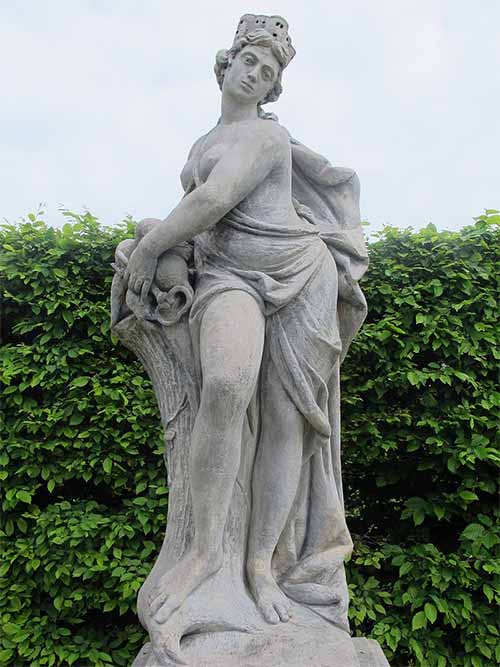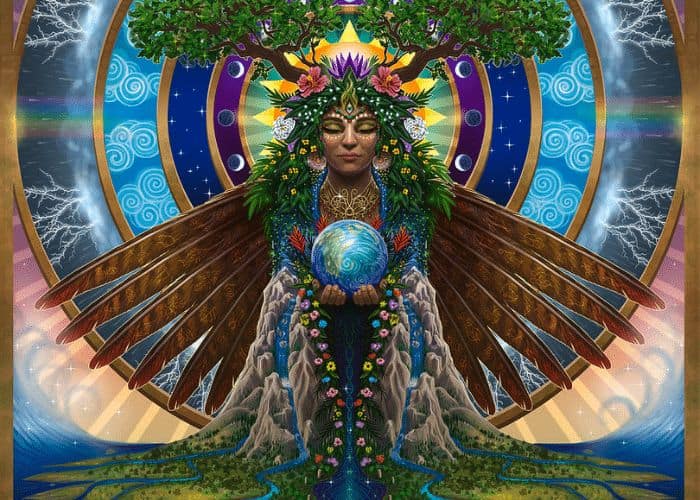Gaea is one of the most revered and influential figures in Greek mythology. She is often referred to as the mother of all creation and is believed to be the goddess of the earth. According to Greek mythology, Gaea was born out of chaos and was responsible for creating the land, sea, and sky.
Gaea is often depicted as a beautiful and influential figure with long flowing hair and a serene expression. She is associated with fertility, agriculture, and the seasons and is considered one of the most important deities in the Greek pantheon. Gaea is also closely associated with the cycle of life and death and is believed to be responsible for the growth and decay of all living things.
As the mother of all creation, Gaea is revered for her power and wisdom and is often called upon for guidance and protection. Her influence can be seen in many aspects of Greek culture, from the arts to religion, and her legacy continues to be celebrated and honored.
Birth Story and Parents
Gaea, also known as Gaia, is the Greek goddess of the Earth and the mother of all life. According to Greek mythology, she was born from the chaos before the universe was created.
Affairs and Relations
Gaea was married to her son, Uranus, who was also her father. Together, they had many children, including the Titans, the Cyclopes, and the Hecatonchires. However, Uranus was a cruel and domineering husband, and Gaea grew tired of his abuse.
Children
To free herself from Uranus’s tyranny, Gaea conspired with her son Cronus to overthrow him. Cronus castrated Uranus with a sickle, and Gaea used the blood from his wound to create the Furies, the Giants, and the Meliae.
Gaea had many other children, both with Uranus and with other partners. Some of her most famous children include:
- The Titans: Twelve powerful gods who ruled the universe before the Olympians overthrew them.
- The Cyclopes: Three one-eyed giants who forged Zeus’s thunderbolt and other powerful weapons.
- The Hecatonchires: Three giants with a hundred arms and fifty heads each who helped Zeus defeat the Titans.
In Greek mythology, Gaea is often depicted as an influential and nurturing mother figure who gives life to all creatures and protects them from harm. Her children, in turn, are seen as nature’s forces shaping the world and bringing order to the universe’s chaos.
Symbols and Powers
Gaea, the Greek goddess of the earth, was often depicted as a matronly figure with a crown of flowers on her head and holding a cornucopia. As the goddess of the earth, she was associated with fertility, agriculture, and the harvest. She was also known for her powers of prophecy and divination.
One of the symbols associated with Gaea was the serpent. In Greek mythology, the serpent was seen as a symbol of wisdom and knowledge and was often associated with healing and rejuvenation. Gaea was often depicted holding a serpent, symbolizing her connection to the earth and her ability to bring forth new life.
Another symbol associated with Gaea was the oak tree. The oak tree was seen as a symbol of strength and longevity and was often associated with the gods and goddesses of the earth. Gaea was often depicted as being surrounded by oak trees, which symbolized her power over the natural world and her connection to the earth.

In addition to her powers of prophecy and divination, Gaea was also known for her ability to control the elements of the earth. She was said to be able to create earthquakes and control the weather and was often called upon to bring rain or sunshine to the crops.
Overall, Gaea was an influential and revered goddess in Greek mythology, and her symbols and powers reflected her connection to the earth and her ability to control the natural world.
Death
In Greek mythology, Gaea was the goddess of the earth. She was revered as the mother of all creation and was believed to be the source of all life. However, like everything in life, Gaea also had a darker side. She was also associated with death and destruction.
Gaea’s connection to death was often depicted in her association with the cycle of life and death. Just as she was the source of life, she was also the ultimate destination of all life. When a living being died, it was believed that their soul would return to Gaea, where it would be absorbed into the earth and become part of the cycle of life again.
Gaea’s role in death was also depicted in her association with other gods and goddesses associated with death. For example, Gaea was often associated with Hades, the god of the underworld, who was responsible for the souls of the dead. It was believed that Gaea and Hades worked together to ensure that life and death continued without interruption.
In addition to her association with Hades, Gaea was associated with Thanatos, the god of non-violent death. It was believed that Thanatos was responsible for guiding the souls of the dead to the underworld, where they would be judged and sent to their final resting place. Gaea’s association with Thanatos further emphasized her role in the cycle of life and death.
Gaea’s connection to death was an essential part of her mythology. While she was revered as the mother of all creation, she was also recognized as the ultimate destination of all life. Her association with other gods and goddesses associated with death further emphasized her role in the cycle of life and death.
Worship
Gaea was one of the most revered gods in ancient Greece, and her worship dates back to prehistoric times. She was considered the goddess of the earth and was worshipped as the mother of all life. Many Greeks believed that all living things were born from her and that she was responsible for the earth’s fertility.
Gaea was worshipped in many ways, and her followers included farmers, hunters, and other people who relied on the earth for their livelihood. Many temples and shrines were dedicated to her, and she was often depicted in art and literature.
Interesting Facts
- Gaea was often worshipped alongside gods such as Zeus, Apollo, and Dionysus.
- In some myths, Gaea was portrayed as a vengeful goddess who would punish those who harmed the earth.
- The worship of Gaea was often associated with the worship of other goddesses, such as Demeter and Persephone.
- Gaea was sometimes depicted as a serpent or a dragon, symbolizing her power over the earth.
- The worship of Gaea declined in popularity during the Hellenistic period as the focus of Greek religion shifted to other gods and goddesses.
Overall, the worship of Gaea played an essential role in ancient Greek society, and her influence can still be seen in modern culture. Her portrayal as the mother of all life and the protector of the earth has resonated with people for thousands of years, and her legacy continues to inspire reverence and respect for the natural world.
Gaea and Zeus and Her Sons
Details
Gaea, also known as Mother Earth, is one of Greek mythology’s oldest and most potent deities. She is the daughter of Chaos and the mother of Uranus, the sky god. Gaea is often depicted as a nurturing and loving mother figure, but she is also known for her fierce and vengeful nature.
One of Gaea’s most significant relationships in Greek mythology is with her son Zeus. Zeus is the king of the gods and the ruler of the sky, while Gaea is the goddess of the earth. Despite their different domains, Zeus and Gaea share a close relationship.
Gaea played a critical role in Zeus’s rise to power. According to Greek mythology, Zeus overthrew his father, Cronus, with the help of Gaea. Cronus had swallowed all his children, including Zeus, to prevent them from overthrowing him. Gaea helped Zeus escape from Cronus’s stomach and gave him a potion that would make him vomit up his siblings. With Gaea’s help, Zeus could defeat Cronus and become the king of the gods.
Gaea and Zeus also had several sons together, including the gods Poseidon and Hades. Poseidon is the god of the sea, while Hades is the underworld god. Both gods play significant roles in Greek mythology and are often depicted as powerful and fearsome figures.
In conclusion, Gaea’s relationship with Zeus and her sons was crucial in Greek mythology. Gaea’s nurturing and protective nature helped Zeus and his siblings overcome their father and become powerful gods in their own right.
Battles and Supremacy in Olympians
Gaea, the Greek goddess of the earth, was one of the Greek pantheon’s oldest and most powerful deities. She was the mother of the Titans, including Cronus, who overthrew his father, Uranus, and Rhea, the mother of the Olympians.
Gaea played a significant role in the battles for supremacy among the gods. She was often depicted as a wise and powerful figure who could foresee the future and manipulate events to her advantage. In some myths, she conspired with her children to overthrow the Olympians and regain control of the cosmos.
One of the most famous battles for supremacy was the Titanomachy, a ten-year war between the Titans and the Olympians. Gaea supported the Titans in rebelling against the Olympians, whom Zeus led. However, Zeus and his siblings ultimately emerged victorious, banishing the Titans to Tartarus and establishing the Olympian gods as the rulers of the cosmos.
Despite her defeat, Gaea remained an influential and respected figure in Greek mythology. She was often associated with fertility, growth, and the natural world and was worshipped by many as a benevolent and nurturing deity.
In conclusion, Battles and Supremacy in Olympians played a significant role in Greek mythology, with Gaea serving as a critical player in many conflicts. While the Olympians ultimately emerged victorious in their battles for supremacy, Gaea remained a robust and influential figure in the Greek pantheon.
Frequently Asked Questions
Who is Gaia?
Gaia is a Greek goddess who personifies the Earth. She is considered the mother of all life, and her name means “land” or “earth.” She is often depicted as a beautiful woman with a serene, nurturing expression, and she is associated with fertility, growth, and abundance.
What is the meaning of Gaia?
The meaning of Gaia is closely tied to the Earth itself. In Greek mythology, Gaia is seen as the embodiment of the planet and is often called the “Mother Earth.” Her name also carries connotations of fertility, growth, abundance, and the cycles of life and death.
What are the powers of the goddess Gaia?
As the goddess of the Earth, Gaia is believed to have immense power over the natural world. She is associated with fertility, growth, and abundance, and she is said to have the ability to control the weather, the seasons, and the growth of crops. She is also believed to have healing powers and the ability to grant fertility to women.
What is the symbol of the goddess Gaia?
The symbol of Gaia is often represented as a globe or sphere, representing the Earth itself. She is also sometimes depicted with a cornucopia, symbolizing abundance and fertility.
Who did Gaia give birth to?
Gaia is said to have given birth to many Greek gods and goddesses, including Uranus, the sky god, and Pontus, the god of the sea. She is also said to have given birth to the Titans, the first generation of gods and goddesses.
Who were the parents of Gaia?
In Greek mythology, Gaia is said to have been born from Chaos, the void that existed before the creation of the universe. She is also sometimes described as the daughter of Aether, the god of the upper atmosphere, and Hemera, the goddess of the day.

